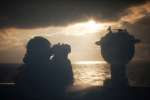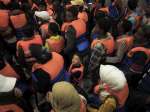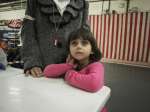- Text size
 |
|  |
|  |
| 
- Français
European leaders strongly urged to put human life, rights and dignity first in Mediterranean decision
News Stories, 23 April 2015
GENEVA, April 23 (UNHCR) – The UN refugee agency on Thursday joined other organizations in a call on European leaders to put human life, rights and dignity first today when agreeing upon a common response to the humanitarian crisis in the Mediterranean.
"A tragedy of epic proportions is unfolding in the Mediterranean," stressed the joint statement, which was signed by UN High Commissioner for Refugees António Guterres, UN High Commissioner for Human Rights Zeid Ra'ad Al Hussein, Special Representative of the UN Secretary-General for International Migration and Development Peter Sutherland, and Director-General of the International Organization for Migration William Lacy Swing.
Noting that the European Union (EU) was founded on fundamental principles of humanity, solidarity and respect for human rights, the statement said: "We urge EU Member States to demonstrate moral and political leadership in adopting a holistic and forward-looking action plan centred upon these values."
It added that the European Union response "must go beyond the present minimalist approach in the 10-Point Plan of Action" announced on Monday, which focuses primarily on stemming the arrival of migrants and refugees on its shores.
"As a paramount principle, the safety, protection needs and human rights of all migrants and refugees should be at the forefront of the EU response. EU leaders must look beyond the present situation and work closely with transit and origin countries both to alleviate the immediate plight of migrants and refugees and address in a more comprehensive way the many factors that drive them to resort to such desperate journeys by sea. Enforcement alone will not solve the issue of irregular migration, but could increase the risks and abuse faced by migrants and refugees.
The statement concluded: "We would therefore encourage bold, collective action to expand the range of measures under consideration to include:
- Setting in place a state-led, robust, proactive, and well-resourced search-and-rescue operation, urgently and without delay, with a capacity similar to Mare Nostrum and a clear mission to save lives.
- Creating sufficient channels for safe and regular migration, including for low-skilled migrant workers and individuals in need of family reunification, and access to protection where needed, as safe alternatives to resorting to smugglers.
- Making a firm commitment to receive significantly higher numbers of refugees through EU-wide resettlement, in addition to current quotas, and on a scale which will make a real impact, combined with other legal means for refugees to reach safety.
- Bolstering arrangements to support those countries receiving the most arrivals (Italy, Malta and Greece) and to distribute responsibility more equitably across the European Union for saving lives and protecting all those in need.
- Combatting racist and xenophobic rhetoric vilifying migrants and refugees.
EU leaders were due to hold an emergency summit later Thursday in Brussels to find ways to stem the number of people risking their lives while trying to cross the Mediterranean to Europe.












































